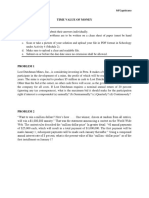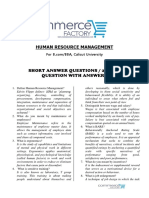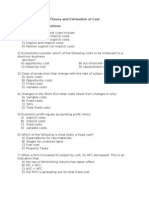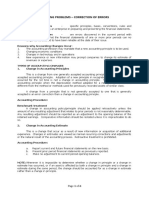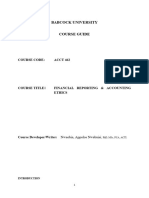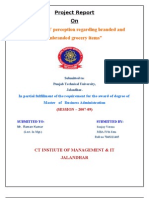Chapter 7 Managerial Economics Paul Keat Solution
Chapter 7 Managerial Economics Paul Keat Solution
Uploaded by
wcm007Copyright:
Available Formats
Chapter 7 Managerial Economics Paul Keat Solution
Chapter 7 Managerial Economics Paul Keat Solution
Uploaded by
wcm007Original Title
Copyright
Available Formats
Share this document
Did you find this document useful?
Is this content inappropriate?
Copyright:
Available Formats
Chapter 7 Managerial Economics Paul Keat Solution
Chapter 7 Managerial Economics Paul Keat Solution
Uploaded by
wcm007Copyright:
Available Formats
lOMoARcPSD|34929887
Chapter 7 Managerial Economics Paul Keat Solution
Economic (Institute of Business Administration)
Studocu is not sponsored or endorsed by any college or university
Downloaded by Rawan Alamoudi (wcm007@st.ubt.edu.sa)
lOMoARcPSD|34929887
Managerial Economics, 7e, Global Edition (Keat)
Chapter 7 The Theory and Estimation of Cost (Appendices 7A, 7B, and 7C)
Multiple-Choice Questions
1) To an economist, total costs include
A) explicit, but not implicit costs.
B) implicit, but not explicit costs.
C) explicit and implicit costs.
D) neither explicit nor implicit costs.
Answer: C
Diff: 1
2) Economists consider which of the following costs to be irrelevant to a short-run business
decision?
A) opportunity cost
B) out-of-pocket cost
C) historical cost
D) replacement cost
Answer: C
Diff: 1
3) Which of the following is a relevant cost?
A) replacement cost
B) sunk cost
C) historical cost
D) fixed cost
E) All of the above are relevant.
Answer: A
Diff: 1
4) Which of the following distinctions helps to explain the difference between relevant and
irrelevant cost?
A) accounting cost vs. direct cost
B) historical cost vs. replacement cost
C) sunk cost vs. fixed cost
D) variable cost vs. incremental cost
Answer: B
Diff: 1
Downloaded by Rawan Alamoudi (wcm007@st.ubt.edu.sa)
lOMoARcPSD|34929887
5) Which of the following distinctions does not help to explain the difference between relevant
and irrelevant cost?
A) historical vs. replacement cost
B) sunk vs. incremental cost
C) variable vs. fixed cost
D) out-of-pocket vs. opportunity cost
E) All help to explain the difference.
Answer: D
Diff: 2
6) Costs of production that change with the rate of output are
A) sunk costs.
B) opportunity costs.
C) fixed costs.
D) variable costs.
Answer: D
Diff: 1
7) Changes in the short-run total costs result from changes in only
A) variable costs.
B) fixed costs.
C) zero.
D) total fixed costs.
Answer: A
Diff: 1
8) Economic profit equals accounting profit minus
A) explicit costs.
B) implicit costs.
C) fixed costs.
D) variable costs.
Answer: B
Diff: 1
9) Which of the following is most likely a fixed cost?
A) expenditures for raw materials
B) wages for unskilled labor
C) fuel cost
D) property taxes
Answer: D
Diff: 1
Downloaded by Rawan Alamoudi (wcm007@st.ubt.edu.sa)
lOMoARcPSD|34929887
10) Average fixed cost
A) does not change as total output increases or decreases.
B) varies directly with total output.
C) falls continuously as total output expands.
D) rises as the output is expanded.
Answer: C
Diff: 1
11) Average fixed cost is
A) AC minus AVC.
B) TC divided by Q.
C) AVC minus MC.
D) TC minus TVC.
Answer: A
Diff: 1
12) Which of the following cost relationships is not true?
A) AFC = AC - MC
B) TVC = TC - TFC
C) The change in TVC/the change in Q = MC
D) The change in TC/ the change in Q = MC
Answer: A
Diff: 2
13) When a firm increased its output by one unit, its AFC decreased. This is an indication that
A) the law of diminishing returns has taken effect.
B) MC < AFC.
C) AVC < AFC.
D) the firm is spreading out its total fixed cost.
Answer: D
Diff: 3
14) The distinction between sunk and incremental costs is most helpful in answering which
question?
A) How many more people should be added to the production process?
B) What is the correct price to charge?
C) Should we begin to build a new factory?
D) Should we continue developing a new software application that we began last year?
Answer: D
Diff: 2
Downloaded by Rawan Alamoudi (wcm007@st.ubt.edu.sa)
lOMoARcPSD|34929887
15) Which of the following relationships is correct?
A) When marginal product starts to decrease, marginal cost starts to decrease.
B) When marginal cost starts to increase, average cost starts to increase.
C) When marginal cost starts to increase, average variable cost starts to increase.
D) When marginal product starts to decrease, marginal cost starts to increase.
Answer: D
Diff: 2
16) The relationship between MC and AC can best be described as
A) when AC increases, MC starts to increase.
B) when MC increases, AC starts to increase.
C) when MC decreases, AC decreases.
D) when MC exceeds AC, AC increases.
Answer: D
Diff: 2
17) The law of diminishing returns begins first to affect a firm's short-run cost structure when
A) average variable cost begins to increase.
B) marginal cost begins to increase.
C) average cost begins to increase.
D) average fixed cost begins to decrease.
Answer: B
Diff: 2
18) When a firm increased its output by one unit, its AC rose from $45 to $50. This implies that
its MC is
A) $5.
B) between $45 and $50.
C) greater than $50.
D) Cannot be determined from the above information
Answer: C
Diff: 3
19) When a firm's MC curve shifts to the right, it implies that
A) new firms are entering the market.
B) labor productivity is decreasing.
C) labor productivity is increasing.
D) the firm's overhead costs are decreasing.
Answer: C
Diff: 3
Downloaded by Rawan Alamoudi (wcm007@st.ubt.edu.sa)
lOMoARcPSD|34929887
20) MC increases because
A) MC naturally increases as the firm nears capacity.
B) labor is paid overtime wages when volume increases.
C) in the short run, MC always increases.
D) the law of diminishing returns takes effect.
Answer: D
Diff: 3
21) The marginal cost will intersect the average variable cost curve
A) when the average variable cost curve is rising.
B) where average variable cost curve equals price.
C) at the minimum point of the average variable cost curve.
D) The two will never intersect.
Answer: C
Diff: 2
22) Which of the following cost functions will exhibit both decreasing and increasing marginal
costs?
A) a cubic cost function
B) a quadratic cost function
C) a linear cost function
D) All of the above
Answer: A
Diff: 2
23) Which of the following statements best represents a difference between short-run and long-
run cost?
A) Less than one year is considered the short run; more than one year the long run.
B) There are no fixed costs in the long run.
C) In the short-run labor must always be considered the variable input and capital the fixed input.
D) All of the above are true.
Answer: B
Diff: 1
24) When a firm increased its output by one unit, its AC decreased. This implies that
A) MC < AC.
B) MC = AC.
C) MC < AFC.
D) the law of diminishing returns has not yet taken effect.
Answer: A
Diff: 3
Downloaded by Rawan Alamoudi (wcm007@st.ubt.edu.sa)
lOMoARcPSD|34929887
25) The main factor that explains the difference between accounting cost and economic cost is
A) opportunity cost.
B) fixed cost.
C) variable cost.
D) All of the above help to explain the difference.
Answer: A
Diff: 2
26) When a firm experiences increasing returns to scale
A) its AFC will decrease.
B) its AFC will increase.
C) its AC will increase.
D) its AC will decrease.
Answer: D
Diff: 2
27) If a firm's rent increases, it will affect its cost structure in which of the following ways?
A) AVC will increase.
B) MC will increase.
C) TFC will increase.
D) All of the above will increase.
Answer: C
Diff: 2
28) Which of the following relationships implies that a firm's short-run cost function is linear?
A) MC = AC
B) MC = AVC
C) AC = AFC + AVC
D) MC > AC
Answer: B
Diff: 3
29) The learning curve
A) is really no different from a marginal cost curve.
B) calculates average cost at a particular point in time.
C) shows the decrease in unit cost as more of the same product is produced over time.
D) None of the above
Answer: C
Diff: 1
30) The learning curve indicates that
A) economies of scale are taking effect.
B) repetition of various production tasks cause unit costs to decrease.
C) workers must learn new skills in order to improve.
D) it takes time to learn a new skill.
Answer: B
Diff: 1
6
Downloaded by Rawan Alamoudi (wcm007@st.ubt.edu.sa)
lOMoARcPSD|34929887
31) Which level indicates the point of maximum economic efficiency?
A) lowest point on AC curve
B) lowest point on AVC curve
C) lowest point on MC curve
D) None of the above
Answer: A
Diff: 2
32) Which of the following actions has the best potential for experiencing economies of scope?
A) producing a product that has appeal to a wider segment of the market
B) producing computers and software
C) producing spaghetti and soft drinks
D) producing cars and trucks
Answer: D
Diff: 2
33) If total cost equals $2,000 and quantity produced is 100 units, then
A) fixed cost is $200 and average variable cost is $18.
B) fixed cost is $600 and average variable cost is $14.
C) fixed cost is $500 and marginal cost is $15.
D) Either A or B can be correct.
Answer: D
Diff: 3
34) A short-run total cost function, TC = 100 + 32Q - 4Q2 + 0.4Q3, indicates the existence of
A) a linear total cost curve.
B) a constant average variable cost curve.
C) a U-shaped average variable cost curve.
D) a constant marginal cost curve.
Answer: C
Diff: 3
35) The results of many empirical studies of short-run cost functions have shown that total costs
conform to
A) a quadratic total cost function.
B) a power cost function.
C) a linear cost function.
D) a cubic cost function.
Answer: C
Diff: 1
Downloaded by Rawan Alamoudi (wcm007@st.ubt.edu.sa)
lOMoARcPSD|34929887
36) Among the problems encountered when time series analysis is used to estimate cost functions
is
A) that technological changes may have occurred.
B) that accounting changes may have occurred during the period analyzed.
C) that some costs are recorded on the books of account at a time other than when they are
incurred.
D) All of the above
Answer: D
Diff: 2
37) The method of estimating long-run costs in which knowledgeable professionals familiar with
production facilities and processes calculate optimal combination of inputs to produce given
quantities and then estimate costs is known as
A) engineering cost estimating.
B) the survivorship method.
C) regression analysis.
D) None of the above
Answer: A
Diff: 2
38) When the survivorship method of cost estimating is used, an increase, over time, in the
proportion of industry product produced by medium size firms indicates the existence of
A) continuing economies of scale.
B) continuing diseconomies of scale.
C) a U-shaped long-run average cost curve.
D) large technological changes.
Answer: C
Diff: 2
39) The major advantage of using cross-sectional analysis for long-run costs studies includes
A) the inclusion in the sample of different plants of different sizes.
B) the avoidance of having to adjust for inflationary trends.
C) the avoidance of having to account for interregional cost differences.
D) All of the above
E) A and B above
Answer: E
Diff: 2
40) In the long run
A) fixed costs tend to be greater than variable costs.
B) variable costs tend to be greater than fixed costs.
C) all costs are fixed costs.
D) all costs are variable costs.
Answer: D
Diff: 1
Downloaded by Rawan Alamoudi (wcm007@st.ubt.edu.sa)
lOMoARcPSD|34929887
41) Assuming the existence of economies of scale, if a firm finds that it can reduce its unit cost
by decreasing its scale of production, it means that
A) it has too much production capacity relative to its demand.
B) it should try to produce less.
C) the law of diminishing returns has not taken effect.
D) it has too much fixed overhead relative to its variable cost.
Answer: A
Diff: 2
42) As a firm attempts to increase its production, its long-run average costs eventually rise
because of
A) the law of diminishing returns.
B) diseconomies of scale.
C) fixed capital.
D) insufficient demand.
Answer: B
Diff: 1
43) Economies of scale are created by greater efficiency of capital and by
A) longer chains of command in management.
B) better wages for labor.
C) smaller plant sizes.
D) increased specialization of labor.
Answer: D
Diff: 2
44) Economies of scale are indicated by
A) declining long-run AVC.
B) declining long-run AFC.
C) declining long-run AC.
D) declining long-run TC.
Answer: C
Diff: 1
45) Which of the following is a reason for economies of scale?
A) Fixed costs are spread out as volume increases.
B) The law of diminishing returns does not take effect.
C) Input productivity increases as a result of greater specialization.
D) There is greater savings in transportation costs.
Answer: C
Diff: 2
Downloaded by Rawan Alamoudi (wcm007@st.ubt.edu.sa)
lOMoARcPSD|34929887
46) Diseconomies of scale can be caused by
A) the law of diminishing returns.
B) bureaucratic inefficiencies.
C) increasing advertising and promotional costs.
D) All of the above
Answer: B
Diff: 1
47) Which of the following is the best example of economies of scope?
A) Coca-Cola expands its global operations to sub-Sahara Africa.
B) Alcohol for car fuel is produced from corn.
C) Amazon.com decides to rent out its Web site to independent e-commerce companies.
D) A company reduces its cost by getting bigger discounts for bulk purchases.
Answer: C
Diff: 2
48) Short-run cost functions are estimated using
A) time-series regression analysis.
B) cross-sectional regression analysis.
C) nominal cost data.
D) present value cost data.
Answer: A
Diff: 1
49) In estimating short-run cost functions, one must adjust for
A) price level changes.
B) accounting procedure changes.
C) product heterogeneity.
D) All of the above
Answer: D
Diff: 1
50) Long-run cost functions are estimated using
A) time-series regression analysis.
B) cross-sectional regression analysis.
C) cost accounting data.
D) None of the above
Answer: B
Diff: 1
10
Downloaded by Rawan Alamoudi (wcm007@st.ubt.edu.sa)
lOMoARcPSD|34929887
Analytical Questions
1) You have opened your own word-processing service. You bought a personal computer, and
paid $5,000 for it. However, due to the cost changes in the computer industry, the current price of
an equivalent machine is $2,500. You could sell any used machine for $1,000. If you were not
word processing, you could earn $20,000 per year at an alternative job. Assume that the interest
rate is 10%. You can also hire an assistant who can do everything that you can do for $20,000 per
year (you would still continue to do word processing).
One person using one computer can produce 11,000 typed pages per year, and the price per page
for your service is $2.
You are considering three options: (1) expand your business by hiring an assistant; (2) leave your
business the way it is; (3) shut down. Based on the costs and revenues above, which should you
do? Explain and show any relevant calculations.
Answer:
Option 1:
Revenue = $22,000
Opportunity cost of your time = 20,000
Opportunity cost of interest on salvage value of existing computer = 100
Economic profit = $1,900
Option 2:
You still earn $1,900 as above.
Revenue from additional worker = 22,000
Wages = 20,000
Opportunity cost of interest on purchase of new computer = 250
Depreciation = 1,500
Economic profit from additional worker = $250
Total economic profit = $2,150
Option 3:
Revenue = 0
No costs, since opportunity costs no longer apply, and fixed costs are sunk.
Economic profit = 0
(Could possibly view the $1,000 you get from selling the used computer as revenue, but makes
no difference to final solution of problem.)
Option 2, expand your business, is the best option.
11
Downloaded by Rawan Alamoudi (wcm007@st.ubt.edu.sa)
lOMoARcPSD|34929887
2) Fred's Widget Company has purchased $500,000 in equipment, which can be sold for a
salvage value of $300,000 at any time. The best interest rate on alternative investments is 5%.
What is the cost of using this machinery for one year? How would your answer be different if the
machinery had not yet been purchased?
Answer: Short-run cost = $15,000
Cost if the machinery was not purchased = $200,000 + $25,000 = $225,000
Explanation: The short-run cost is just the forgone interest. The short-run depreciation is sunk,
and the salvage value doesn't change. The long-run cost (if the machine has not been purchased)
is the depreciation cost plus the foregone interest on the whole $500,000.
3) The following table shows the relationship between output and number of workers in the short
run. If the wage is $50/day, find marginal cost of production.
Number of
Workers Output
0 0
1 50
2 110
3 300
4 450
5 590
6 665
7 700
8 725
9 740
10 735
Answer:
Number
of Workers Output MPL MC (=w/MPL)
0 0 -- --
1 50 50 1.00
2 110 60 0.91
3 300 190 0.26
4 450 150 0.33
5 590 140 0.36
6 665 75 0.67
7 700 35 1.43
8 725 25 2.00
9 740 15 3.33
10 735 -5 --
12
Downloaded by Rawan Alamoudi (wcm007@st.ubt.edu.sa)
lOMoARcPSD|34929887
4) Consider a firm that has just built a plant, which cost $1,000. Each worker costs $5.00 per
hour. Based on this information, fill in the table below.
Number of Average
Marginal Fixed Variable Total Marginal Average
Worker Output Variable
Product Cost Cost Cost Cost Total Cost
Hours Cost
0 0 -- -- --
50 400
100 900
150 1300
200 1600
250 1800
300 1900
350 1950
Answer:
Number of Average
Marginal Fixed Variable Total Marginal Average
Worker Output Variable
Product Cost Cost Cost Cost Total Cost
Hours Cost
0 0 -- 1,000 0 1,000 -- -- --
50 200 4 1,000 250 1,250 1.25 1.25 6.25
100 700 10 1,000 500 1,500 0.50 0.7143 2.1429
150 1400 14 1,000 750 1,750 0.3571 0.5357 1.25
200 1650 5 1,000 1000 2,000 1 0.6061 1.2121
250 1800 3 1,000 1250 2,250 1.6667 0.6944 1.25
300 1900 2 1,000 1500 2,500 2.50 0.7895 1.3158
350 1975 1.5 1,000 1750 2,750 3.3333 0.8861 1.3924
5) How would each of the following affect the firm's marginal, average, and average variable
cost curves?
a. An increase in wages
b. A decrease in material costs
c. The government imposes a fixed amount of tax.
d. The rent that the firm pays on the building that it leases decreases.
Answer:
a. Wages are a variable cost, so MC, AVC, and ATC increase.
b. Materials are a variable cost, so MC, AVC, and ATC decrease.
c. A fixed or lump-sum tax increases ATC but not MC or AVC.
d. Rent is generally viewed as a fixed cost, so ATC decreases, but MC and AVC are unchanged.
13
Downloaded by Rawan Alamoudi (wcm007@st.ubt.edu.sa)
lOMoARcPSD|34929887
6) A firm experiences increasing returns to scale; that is, doubling all its inputs more than
doubles its output. What can be inferred about the firm's short-run costs?
Answer: Returns to scale is a long-run phenomenon because all inputs must be changed. Thus
we can infer little about the firm's short-run costs from this information, other than the firm is
likely to experience diminishing marginal returns in the short run due to the fact that it will have
a fixed factor of production (and thus short-run marginal costs will rise with output).
7) Carefully explain if the following statements are true, false, or uncertain.
a. If average cost is increasing, marginal cost must be increasing.
b. If there are diminishing returns, the marginal cost curve must be positively sloped.
c. Marginal costs decrease as output increases because the firm can spread fixed costs over
more units.
Answer:
a. True. If average cost is increasing, marginal cost must be above average cost, so marginal
cost must be increasing.
b. True. If there are diminishing returns, each worker produces less than the one before him.
Thus each unit must be getting more expensive (because you pay workers the same amount but
they produce less).
c. False. Marginal costs have nothing to do with fixed costs. The statement would be correct if
it was about average costs.
8) Carefully explain the difference between diseconomies of scale and diminishing returns.
Answer: Diseconomies of scale means that, in the long run, average costs are rising, usually due
to coordination problems or decreasing returns to scale. Diminishing returns means that, in the
short run, marginal product is falling (or marginal cost is rising) because each additional worker
is producing less than the one before him, due to the fact that capital (or some other factor of
production) is fixed. There is no connection between these things.
9) For each of the following cost functions, find MC, AC, and AVC.
a. TC = 20,000 + 10 Q
b. TC = 18,000 + Q + 0.2 Q2
Answer:
a. MC = 10
AC = (20,000/Q) + 10
AVC = 10
b. MC = 1 + 0.4Q
AC = (18,000/Q) + 1 + 0.2Q
AVC = 1 + 0.2Q
14
Downloaded by Rawan Alamoudi (wcm007@st.ubt.edu.sa)
lOMoARcPSD|34929887
10) For each of the following cost functions, if possible, find minimum AC and minimum AVC.
a. TC = 20,000 + 10 Q
b. TC = 18,000 + Q + 0.2 Q2
Answer:
a. Set MC = AC.
10 = (20,000/Q) + 10
In this case, AC is decreasing everywhere, and thus there is
no minimum average cost (although it will approach $10).
Set MC = AVC.
10 = 10
MC = AVC = 10 for all values of Q in this instance.
b. Set MC = AC.
1 + 0.4Q = (18,000/Q) + 1 + 0.2Q
Q = 300, and at that point, AC = $121.
Set MC = AVC.
1 + 0.4Q = 1 + 0.2Q
Q = 0, and at that point, AVC = $1.
11) Given the total cost function TC = 100 + 40Q - 15Q2 + 5Q3, calculate the
a. average fixed cost function (AFC)
b. average variable cost function (AVC)
c. marginal cost function (MC)
Answer:
a. AFC = 100/Q
b. AVC = 40 - 15Q + 5Q2
c. MC = 40 - 30Q + 15Q2
12) Given the production function Q = 21X + 9X2 - X3, where Q = Output, and X = Input
a. At what value of X does Stage II of the production function begin?
b. At what value of X does Stage III of the production function begin?
c. At what value of X does diminishing returns set in?
Answer:
a. Stage II begins when AP is at a maximum, or X = 4.5
b. Stage III begins where MP = 0, or X = 7 [-1 has no meaning]
c. diminishing returns set in when MP at a maximum, or dMP/dQ = 0, or X = 3
15
Downloaded by Rawan Alamoudi (wcm007@st.ubt.edu.sa)
You might also like
- Belisa Aliyi - Assignments - For - EconometricsDocument34 pagesBelisa Aliyi - Assignments - For - Econometricsfabrahim379No ratings yet
- Activity Based Costing: AnswerDocument4 pagesActivity Based Costing: AnswerMitch Tokong Minglana100% (1)
- HRM Case Study 9-2Document2 pagesHRM Case Study 9-2Farisha RazNo ratings yet
- Chapter 16 Safety, Health, and Risk Management: Human Resource Management, 15e (Dessler)Document45 pagesChapter 16 Safety, Health, and Risk Management: Human Resource Management, 15e (Dessler)moganraj8munusamyNo ratings yet
- Standard Cost Systems: Overview of Brief Exercises, Exercises, Problems, and Critical Thinking CasesDocument56 pagesStandard Cost Systems: Overview of Brief Exercises, Exercises, Problems, and Critical Thinking CasessumanNo ratings yet
- Management Accounting FinalDocument10 pagesManagement Accounting FinalMAGOMU DAN DAVID100% (1)
- Content Marketing Course Emarketing Institute Ebook 2018 Edition PDFDocument161 pagesContent Marketing Course Emarketing Institute Ebook 2018 Edition PDFAmit100% (1)
- CVP AnalysisDocument11 pagesCVP AnalysisPratiksha GaikwadNo ratings yet
- Introduction To Business - Chapter 3 - Entrepreneurship, Franchising and Small BusinessDocument26 pagesIntroduction To Business - Chapter 3 - Entrepreneurship, Franchising and Small BusinessHamidul Islam100% (1)
- Market Structure & CompetitionDocument55 pagesMarket Structure & CompetitionBijendraNo ratings yet
- Financial Statements: Balance Sheet QuestionDocument5 pagesFinancial Statements: Balance Sheet QuestionUsman Ayyub100% (1)
- T Q C 1: C C A: EST Uestions For Hapter Omparable Ompanies NalysisDocument14 pagesT Q C 1: C C A: EST Uestions For Hapter Omparable Ompanies NalysisHe HaoNo ratings yet
- Chapter 7 Motivation ConceptsDocument20 pagesChapter 7 Motivation ConceptsGautham RajeshwaranNo ratings yet
- Question Bank - Management Accounting-1Document5 pagesQuestion Bank - Management Accounting-1Neel Kapoor50% (4)
- Chapter 1 - Individual Exercise: Additional Cases and Worked SolutionsDocument4 pagesChapter 1 - Individual Exercise: Additional Cases and Worked Solutionsshaikha alneyadiNo ratings yet
- Unit 4Document13 pagesUnit 4Elaiya BharathiNo ratings yet
- Fin501: Financial Management MBA BRAC University Final Examination Paper: 3rd of January 2021 Total Time: Three (3) Hours Total: 60 MarksDocument16 pagesFin501: Financial Management MBA BRAC University Final Examination Paper: 3rd of January 2021 Total Time: Three (3) Hours Total: 60 MarksyousufNo ratings yet
- International Performance ManagementDocument13 pagesInternational Performance ManagementBhavita ChhabraNo ratings yet
- Principles of Management Question BankDocument5 pagesPrinciples of Management Question BankPrabhu Easwar100% (2)
- Ba5011 Merchant Banking and Financial Services Reg 17 Question BankDocument5 pagesBa5011 Merchant Banking and Financial Services Reg 17 Question BankAnusha kanmaniNo ratings yet
- Chapter 3 - ST - Make or Buy DecisionsDocument26 pagesChapter 3 - ST - Make or Buy DecisionsSeol Han MinNo ratings yet
- Chapter 16 Budgeting Capital Expenditures Research and Development Expenditures and Cash Pert Cost The Flexible BudgetDocument17 pagesChapter 16 Budgeting Capital Expenditures Research and Development Expenditures and Cash Pert Cost The Flexible BudgetZunaira ButtNo ratings yet
- Assigment (1&2) Statistical Methods (1551) PDF - Docx (21-06-2018) PDFDocument6 pagesAssigment (1&2) Statistical Methods (1551) PDF - Docx (21-06-2018) PDFMaria AsgharNo ratings yet
- Management History: Chapter 2 Stephen P. RobbinsDocument17 pagesManagement History: Chapter 2 Stephen P. RobbinsIbrahim FarooqNo ratings yet
- Time Value of Money General Instructions:: Activity 4 MfcapistranoDocument2 pagesTime Value of Money General Instructions:: Activity 4 MfcapistranoAstrid BuenacosaNo ratings yet
- The Data of Macroeconomics: AcroeconomicsDocument54 pagesThe Data of Macroeconomics: AcroeconomicsAnkur GoelNo ratings yet
- Questio Bank Managerial EconomicsDocument12 pagesQuestio Bank Managerial EconomicsSarthak Bhargava67% (3)
- Answer Key Business Economics-IIDocument3 pagesAnswer Key Business Economics-IISunni ZaraNo ratings yet
- Question Bank Paper: Cost Accounting McqsDocument8 pagesQuestion Bank Paper: Cost Accounting McqsNikhilNo ratings yet
- 2021 Text Book Corporate Financial Accounting Non BsaDocument168 pages2021 Text Book Corporate Financial Accounting Non BsaRemuel A. PascuaNo ratings yet
- Measuring Product CostsDocument71 pagesMeasuring Product CostsNitin100% (1)
- CH 8 Ethics and The EmployeeDocument61 pagesCH 8 Ethics and The EmployeeHadi RazaNo ratings yet
- Strategic HRM Que Bank (30 Que)Document4 pagesStrategic HRM Que Bank (30 Que)DivyeshNo ratings yet
- Cost & Management Accounting - Acc 416Document60 pagesCost & Management Accounting - Acc 416Noorfatihah ZaidiNo ratings yet
- Maryland International College: School of Graduate StudiesDocument3 pagesMaryland International College: School of Graduate StudiesMulgetaNo ratings yet
- Assignment 1Document3 pagesAssignment 1Abebe Nigatu100% (1)
- Chapter 7 Asset Investment Decisions and Capital RationingDocument31 pagesChapter 7 Asset Investment Decisions and Capital RationingdperepolkinNo ratings yet
- Human Resource Management: Short Answer Questions / 2 Mark Question With AnswersDocument3 pagesHuman Resource Management: Short Answer Questions / 2 Mark Question With AnswersANSHID P100% (1)
- Economics For Managerial Decision MakingDocument3 pagesEconomics For Managerial Decision Makingkamalyadav73373No ratings yet
- Fayol's Fourteen Principles of ManagementDocument5 pagesFayol's Fourteen Principles of ManagementLyceum Lawlibrary0% (1)
- External CompetitivenessDocument33 pagesExternal Competitivenesssnehagpt100% (1)
- Sample Test Questions For EOQDocument5 pagesSample Test Questions For EOQSharina Mhyca SamonteNo ratings yet
- Cost Accounting Versus Financial Accounting: Prepared by Hazraphine S. LinsoDocument3 pagesCost Accounting Versus Financial Accounting: Prepared by Hazraphine S. LinsoSaif Kamaong AlimNo ratings yet
- Models of OBDocument15 pagesModels of OBrkpreethiNo ratings yet
- Magerial Economics Ms 09Document271 pagesMagerial Economics Ms 09smartsatish100% (1)
- Pom - MCQDocument14 pagesPom - MCQsmadankvel100% (1)
- Accounting 2304 - Final Exam Practice: Tables ChairsDocument12 pagesAccounting 2304 - Final Exam Practice: Tables ChairsBella Ball100% (1)
- Hris in MepcoDocument83 pagesHris in MepcoMuhammad MuddasirNo ratings yet
- BBA - Introduction To Mathematics Course OutlineDocument7 pagesBBA - Introduction To Mathematics Course OutlineWAHAJ ALINo ratings yet
- What Are The Types of Costs in Cost Accounting?Document3 pagesWhat Are The Types of Costs in Cost Accounting?NURUL AMALINA BINTI ROSLI STUDENTNo ratings yet
- Chapter 8Document4 pagesChapter 8Cfacfa InNo ratings yet
- Business Economics - Assignment 1Document2 pagesBusiness Economics - Assignment 1Sachin ThakurNo ratings yet
- Budgetary ControlDocument28 pagesBudgetary ControlDidie Diyanah0% (1)
- Questions Related To Planning (Chapter 4)Document14 pagesQuestions Related To Planning (Chapter 4)Wilson AdrikoNo ratings yet
- Unit 4 Module 7 Decision MakingDocument18 pagesUnit 4 Module 7 Decision MakingJem100% (1)
- Value Chain Management Capability A Complete Guide - 2020 EditionFrom EverandValue Chain Management Capability A Complete Guide - 2020 EditionNo ratings yet
- Chapter 7 Estimation of CostDocument10 pagesChapter 7 Estimation of CostMuhammad AhmedNo ratings yet
- Chapter 07 - Test BankDocument11 pagesChapter 07 - Test Bankwasif ahmedNo ratings yet
- Final Exam 3Document4 pagesFinal Exam 3HealthyYOU50% (2)
- Chapter 6 Test BankDocument14 pagesChapter 6 Test Bankrajalaxmi rajendranNo ratings yet
- CÂU HỎI TRẮC NGHIỆM LESSON 6Document61 pagesCÂU HỎI TRẮC NGHIỆM LESSON 623050813No ratings yet
- Chapter 4 Principles of Option PricingDocument61 pagesChapter 4 Principles of Option Pricingwcm007No ratings yet
- Chapter3-FIN 533-Spring 2022Document15 pagesChapter3-FIN 533-Spring 2022wcm007No ratings yet
- LN04 Keat020827 07 Me LN04 GeDocument44 pagesLN04 Keat020827 07 Me LN04 Gewcm007No ratings yet
- CH 05 Regression OLS Lecture 2Document25 pagesCH 05 Regression OLS Lecture 2wcm007No ratings yet
- Chapter 5 - GeDocument17 pagesChapter 5 - Gewcm007No ratings yet
- Case Analysis SarahDocument6 pagesCase Analysis Sarahmohnish1006No ratings yet
- Alawihao National High School Alawihao, Daet, Camarines Norte Semester: SC Type of ExamDocument5 pagesAlawihao National High School Alawihao, Daet, Camarines Norte Semester: SC Type of Examkurlstine joanne aceronNo ratings yet
- 198Document12 pages198I Putu Eka Arya Wedhana TemajaNo ratings yet
- E Rupee REVIEWSDocument8 pagesE Rupee REVIEWSMohmmedKhayyumNo ratings yet
- Rules For Bullish Wolfewave Structure: What Is The Wolfe Wave?Document6 pagesRules For Bullish Wolfewave Structure: What Is The Wolfe Wave?Aqeel Thakur100% (2)
- ConsignmentDocument4 pagesConsignmentmuhammaddin123100% (2)
- FAP 3e 2021 PPT CH 9 Accounting For ReceivablesDocument46 pagesFAP 3e 2021 PPT CH 9 Accounting For Receivablestrinhnq22411caNo ratings yet
- BLYTHE REPORT Week 7Document32 pagesBLYTHE REPORT Week 7HAMIZAN HUDYNo ratings yet
- Cia - Iii Marketing Management: Submitted ToDocument9 pagesCia - Iii Marketing Management: Submitted ToTejas YadavNo ratings yet
- Notes Brand Comm.Document35 pagesNotes Brand Comm.martina.rolliNo ratings yet
- PHD Comprehensive Exams Study Guide PDFDocument115 pagesPHD Comprehensive Exams Study Guide PDFMDraakNo ratings yet
- Internship ReportDocument25 pagesInternship ReportFaika Nawar NoorNo ratings yet
- Break Even AnalysisDocument19 pagesBreak Even AnalysismitalptNo ratings yet
- FSC Term Project Group 3Document16 pagesFSC Term Project Group 3Udit AgarwalNo ratings yet
- Budget For The Marketing PlanDocument2 pagesBudget For The Marketing PlanSamiya JahanNo ratings yet
- P&G SwotDocument4 pagesP&G SwotSania WaheedNo ratings yet
- Saba Balls ScriptDocument2 pagesSaba Balls Scriptrefuncion.chipre.tenederoNo ratings yet
- Capital Budgeting Cash Flows: Learning GoalsDocument39 pagesCapital Budgeting Cash Flows: Learning GoalsChristian John Linalcoso AranteNo ratings yet
- Hemant Kumar MaharanaDocument3 pagesHemant Kumar MaharanaHemanta Kumar MaharanaNo ratings yet
- AP-01B Correction of ErrorsDocument6 pagesAP-01B Correction of ErrorsmarkNo ratings yet
- Functions of Accounting Gp3 by Professor & Lawyer Puttu Guru PrasadDocument15 pagesFunctions of Accounting Gp3 by Professor & Lawyer Puttu Guru PrasadPUTTU GURU PRASAD SENGUNTHA MUDALIARNo ratings yet
- Advertisement and Sales Management Paper - 2Document2 pagesAdvertisement and Sales Management Paper - 2maheta shivang100% (1)
- Acct 462 ComDocument265 pagesAcct 462 ComdemolaojaomoNo ratings yet
- Chapter 005 TS ABCDocument30 pagesChapter 005 TS ABCLongyin WangNo ratings yet
- Deterministic Inventory ModelsDocument43 pagesDeterministic Inventory ModelsJosé N. LamehNo ratings yet
- Sales Strategy of CadburyDocument10 pagesSales Strategy of Cadburytheroyaldon20008964100% (6)
- Cost, Revenue and ProfitDocument14 pagesCost, Revenue and ProfitAhsan KamranNo ratings yet
- Topic 4 Probabilistic Inventory Control ModelDocument36 pagesTopic 4 Probabilistic Inventory Control ModelCarstene RenggaNo ratings yet
- Consumers' Perception Regarding Branded and Unbranded Grocery ItemsDocument74 pagesConsumers' Perception Regarding Branded and Unbranded Grocery Items01copy100% (5)
























